War Comes to Florida: Women
World War II profoundly reshaped the American home front. Nowhere was this truer than the home and workplace. Nationally, the number of women working for wages rose from 14.6 million in 1941 to nearly 20 million in 1944. By war’s end, married women outnumbered single women in the workplace. Females in Florida—single women, immigrant women, black women, working-class women— had always worked for wages. The great change in the 1940s was the influx of married, middle-class white women to the wage force.
Newspapers, as well as government reports, document the daily “invasion” of women into what had previously been a male sanctuary. “Women are doing virtually all of the cultivating and harvesting,” noted the Tampa Morning Tribune in 1943. In Miami, milkmaids replaced milkmen at Southern Dairy, while women took jobs as pole painters at Florida Power & Light. In Tallahassee, Elizabeth McLean entered the ranks of city policemen; while in St. Petersburg, women replaced men as transit workers. “Lumberjills have invaded Florida,” claimed the Miami Herald, “They are doing practically every job in the saw mill today, and they are even felling trees with probably a soprano ‘Timber!’”
The most dramatic gains achieved by women may have been at the shipyards in Pensacola, Panama City, Tampa, and Jacksonville. By the end of the war, women welders—”Joans of Arc”—became a familiar sight. In Panama City, contractors assumed the role of running laundries, simply because so many women had accepted better-paying jobs and because of the crush of so many families needing urban services. In the rural hamlet of Bealsville in Hillsborough County, Mary Glenn Horton taught school. During the war, she worked at the McCloskey Shipyards in Tampa as a welder’s assistant. Her son recalled that for the first time, he owned two pairs of shoes.
The war’s powerful currents pulled and pushed the always confused world of gender and sexual relationships. Newspapers complained of “Victory Girls” and “VD Girls,” citing genuine concerns about prostitution and social diseases. Hundreds of thousands of women simply came to Florida with hopes of seeing their husbands, brothers, or sweethearts one last time. Wartime Florida, they learned, could be a cold place.
Historians continue to debate the “gains” made during the war. In the Florida Legislature, Mary Lou Baker represented the solitary female. In 1943, she fought and worked to pass a measure known as the “Women’s Emancipation Bill.” In aviation, Jackie Cochran trained pilots and set new flying records. In Daytona Beach, the imperious Mary McCleod Bethune served as president and founder of Bethune-Cookman College. Early in the war, city officials lamented that the conflict would ruin Daytona Beach’s tourist economy. Bethune picked up the telephone, called Eleanor Roosevelt, and recruited a WACS (Women’s Army Corps Service) military base for the city. For most women, war provided new opportunities for old customs. In record numbers, women volunteered for the Red Cross, staffed the USO, and saved newsprint and bacon grease.
Images
-
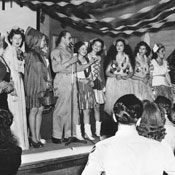
- Halloween party for the troops
-
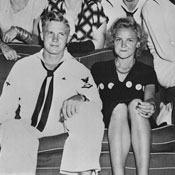
- Naval Air Gunnery School troops and volunteer hostesses
-
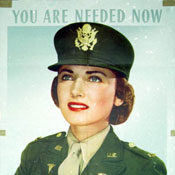
- Army Nurse Corps Poster
-
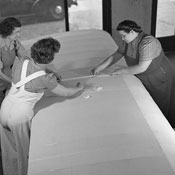
- Sewing plane wing fabric
-
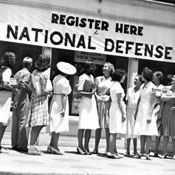
- Volunteer registration at the Civic Exhibition Center : St. Petersburg, Florida
-
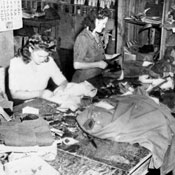
- Women at Camp Gordon Johnston sewing on insignia
-
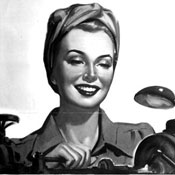
- Woman worker poster
-
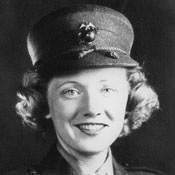
- Portrait of USMC-WR 1st Lieutenant Alice "Martha" Dorn
-
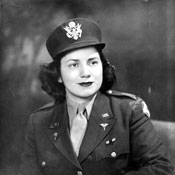
- Portrait of Sarah Kaplan during World War II
-
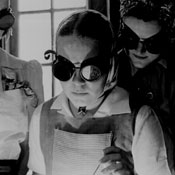
- Women learn war work
-
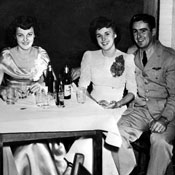
- Dance at the Officer's Club of Dale Mabry Field
Documents
- Bomb-a-Dears: July 25, 1943
- The Bomb-a-Dears were local Tampa Bay girls organized to socialize and entertain troops. The “Briefs from the Bomb-a-Dears” column in the St. Petersburg Times reported on their activities.
- Courtesy of the St. Petersburg Times July 25, 1943
- Virginia D. Brock: Memories of America's World War II Generation
- Mrs. Virginia D. Brock was a Florida native who spent the war years in Stuart, FL. She responded to a call for letters from historian Gary Mormino describing the Florida home front during the World War II years.
- This letter was provided courtesy of Gary Mormino.
- The Bugle Call: Mrs. R.W. Schmoll Sgt. Jeanette Amerson
- On the left side of the page is a piece about Hollywood resident Jeanette Amerson who joined the army, rising through the ranks to sergeant.
- Courtesy of the St. Petersburg Times - September 19, 1943
- Letter from Student at St. Joseph's Academy
- This letter of October 1943 was written by schoolgirl Frances Drew to her father. It speaks of a military parade on “Navy Day” during which two planes collided, killing one pilot. Frances was a schoolteacher for a very short time before returning to school and earning a library degree from Emory University. She spent most of her library career in Georgia and working at the Georgia Institute of Technology for over 30 years before retiring in 1995.
- Transcription
- Courtesy of the Florida State Archives
